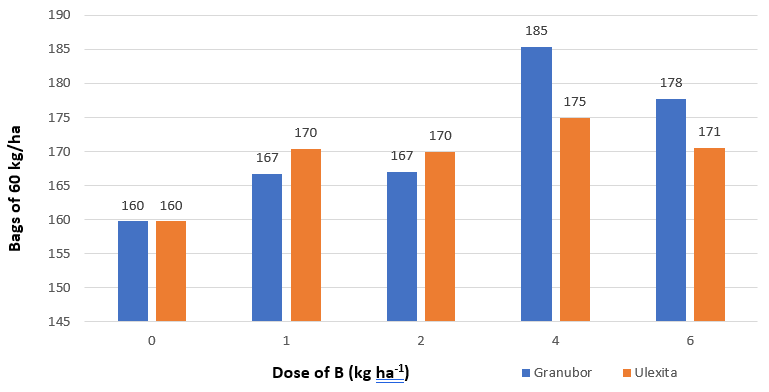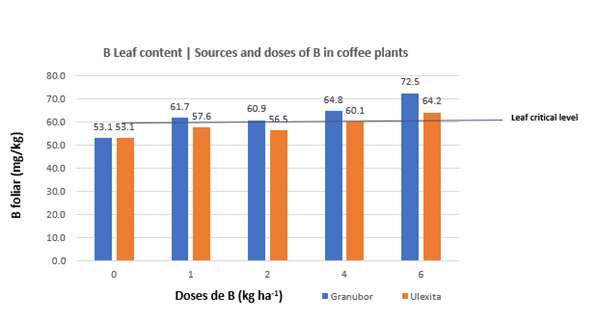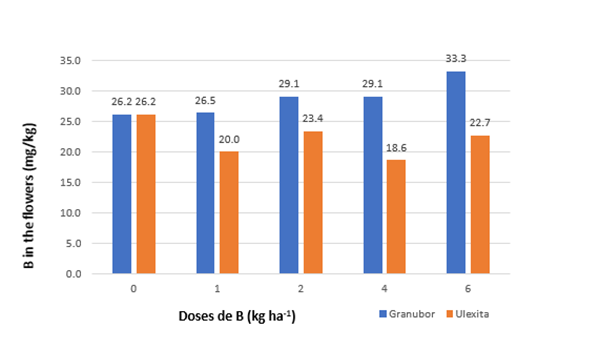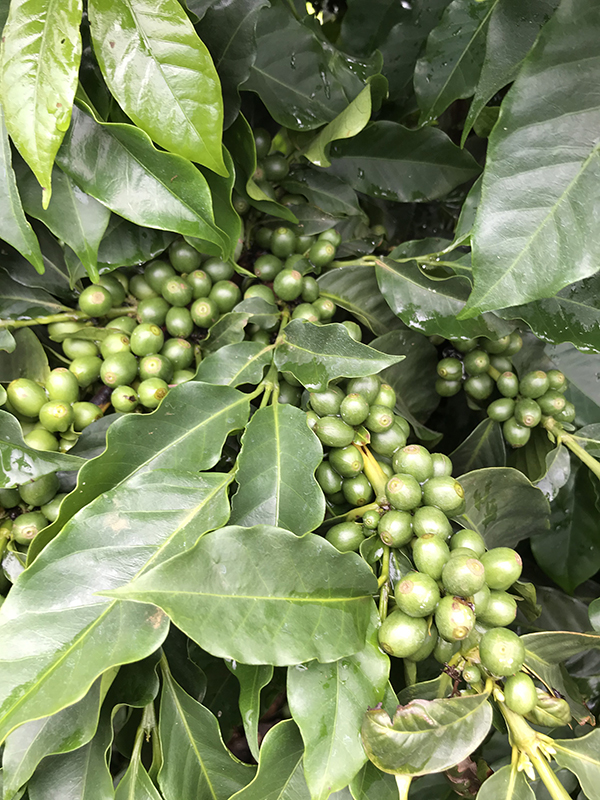Authors
Fabiano Silvestrin, Principal Advisor, Global Market Development Agriculture
Eduardo Saldanha, Agriculture Development Specialist, Latin America
Research has shown that the coffee plant is one of the most sensitive species to boron deficiency. Boron deficiency can cause the following in coffee plants:
- Considerable reduction in root growth and development
- Flower abortion
- Poor fruit formation
- Reduction in productivity, especially in production environments where there is low availability of the nutrient
Boron deficiency: Signs and symptoms
Boron deficiency in coffee is widespread in different coffee-growing areas throughout the world. A study conducted by Ramirez-Builes et al looked at leaf analysis data from 16,000 coffee plant samples from Brazil, Colombia, El Salvador, Guatemala, Kenya, Tanzania, Uganda, and Vietnam. The data revealed that 29% of the samples presented leaf boron concentrations below 45 mg/kg-1 (below the critical leaf level)—meaning there is a high occurrence of coffee production areas with boron deficiency.
Boron deficiency in coffee plants can occur when:
- Boron levels in the soil are below 1.0 mg/dm-3
- There is excessive application of limestone
- High doses of potassium chloride are used
- There are long periods of drought or heavy rainfall
The initial symptoms of boron deficiency appear on new leaves, which become deformed, tapered, small, and with rounded edges. The leaves may also present necrosis, flaccidity, and loss of shine (Figure 1). As symptoms progress to advanced levels, the leaves and terminal buds appear corrugated and deformed—eventually leading to the death of the shoots.
Boron is essential in regions of active growth—meristematic tissue—such as the tips of the roots, as well as developing leaves and shoots. Boron deficiency is often observed through changes in the structure of the plant in these regions of active growth. Franco (1982) observed a marked reduction in the root system of coffee plants as well as death of the ends of the roots. This reduces the root’s ability to absorb water and nutrients, making the coffee plant more sensitive to drought and impairing possible responses to commonly used fertilization programs.
Figure 1: Symptoms of boron deficiency in coffee plants


Boron in coffee cultivation: Evidence from literature
Scientific studies are conclusive in indicating the beneficial effects of boron on coffee crop productivity and quality. Boron is required for the growth and development of coffee plants, and adequate nutrition is essential. Boron deficiency results in biochemical, anatomical, and physiological changes in the plant. According to the literature, the most important physiological effects of boron in plants are:
- Structural component in cell walls
- Structural stability of cell membranes
- Transport of photoassimilates (especially sugars)
- Flowering biology
- Hormonal regulation
For the Catuaí Amarelo coffee plant, Lima Filho and Malavolta (1992) found positive correlations between available boron in the soil and all parameters of the Relative Harvest Index, with the greatest correlation occurring with leaf boron content, branch length, and number of leaves. These variables are important for coffee production because, according to Rena & Maestri (1986), the vertical growth of coffee plants determines the formation of nodes, and in these, the plagiotropic branches will give rise to leaves and inflorescences. Therefore, flowering depends on the growth of the branches, the number of nodes, the number of branches formed and the number of leaves per node, since it is found that many nodes without leaves do not flower.
Furlani Júnior et al (2001), studying the effect of boron on seedlings of the Catuaí Vermelho coffee cultivar, found that plant height, stem diameter, length of plagiotropic branches, number of leaf pairs, and coffee production increased significantly with the addition of boron. The best results were obtained with the application of doses of 1 and 2 g/plant of boron, 19 months after planting. Lima Filho and Malavolta (1998) found a positive and significant correlation between branch length and leaf boron content—the branch length increased as the amount of added boron increased.
A study conducted by Gontijo et al 2008, evaluated the effect of the isolated and simultaneous omission of calcium, boron, copper, and zinc, on the growth, foliar nutrient concentration, and manifestation of visual deficiency symptoms in coffee plants (Coffea arabica L.). The greenhouse study’s experimental design was completely randomized, with four replicates and eight treatments represented by:
- Complete nutrient solution
- Nutrient solution minus calcium
- Nutrient solution minus boron
- Nutrient solution minus copper
- Nutrient solution minus zinc
- Nutrient solution minus calcium and boron
- Nutrient solution minus boron and zinc
- Nutrient solution minus copper and zinc
Each plot consisted of one plant per 2-liter pot. Coffee plants of the Topázio MG 1190 cultivar, from tubes, which had seven pairs of true leaves, were used. Table 1 presents some results involving treatments with isolated or combined omission of element boron. There was a significant effect of isolated or combined omission involving boron on the results of height and diameter of the shoot, leaf area, and number of plagiotropic branches (NRP) of the coffee plants (Table 1). The omission of boron in the nutrient solution reduced the height of the plants, with the treatment composed of the complete solution providing better performance when compared to the others. The isolated omission of boron and combined omission of calcium and boron; and zinc and boron presented lower heights, shoot diameter, leaf area, and number of plagiotropic branches.
Table 1: Shoot height, shoot diameter, leaf area and number of plagiotropic branches (NPB) of coffee plants after 250 days of treatment application.
| Treatment |
Height (cm) |
Diameter (mm) |
Foliar Area (cm2) |
NPB (number) |
| Complete |
31.13 a1 |
p.25 a |
227.44 a |
11.25 a |
| - B |
10.52 d |
4.45 d |
88.21 d |
2.50 d |
| - Ca and B |
10.38 d |
4.25 d |
84.22 d |
2.50 d |
| - Zn and B |
10.08 d |
4.50 d |
88.13 d |
3.50 d |
| CV (%) |
13.22 |
6.52 |
10.64 |
17.40 |
1 Averages followed by the same letter vertically do not differ statistically at 5%, according to the Scott-Knott test
The production of root, shoot, and total dry matter, as well as the relative growth, were significantly influenced by the absence of boron, calcium, and zinc in the nutrient solution (Table 2). The isolated omission of boron; and the simultaneous omission of calcium and boron and boron and zinc resulted in lower root, shoot, and total dry matter mass, with no significant difference between them. It was also observed that the plants grown in the complete solution also presented a greater root and shoot dry matter mass and, consequently, a greater total dry matter mass. The relative growth (CR) was calculated in relation to the results presented by the plants grown in the complete solution, in which the production of total dry matter was greater. Thus, it was verified that the total dry matter produced by the coffee plants grown in the isolated absence of boron and the simultaneous absence of calcium and boron and zinc and boron was less than 20%.
Table 2: Root, shoot, and total dry matter mass; relationship between dry matter mass of aerial part and root (AP/R) and CR of coffee plants after 250 days of application of treatments.
Dry mass (g/plant)
| Treatment |
Root (R) |
Areial part (AP) |
Total |
AP/R |
CR2 (%) |
| Complete |
9.73 a1 |
51.96 a |
61.7a |
5.34a |
100 |
| - B |
4.90 b |
6.35 b |
11.25 d |
1.30 d |
18 |
| - Ca and B |
5.05 b |
6.53 d |
11.58 d |
1.29 d |
19 |
| - Zn and B |
4.91 b |
6.40 d |
11.31 d |
1.30 d |
19 |
| CV (%) |
19.14 |
10.38 |
10.88 |
10.38 |
- |
1 Averages followed by the same letter vertically do not differ statistically at 5%, according to the Scott-Knott test
2 Regarding total dry matter production
Numerous physiological, biochemical, and anatomical effects have been observed in plants with boron deficiency. These are secondary effects of damage to cell walls.Coffee plant leaves with boron deficiency have fewer and malformed stomata. Research conducted by Leite 2002, observed that the quantity and shape of stomata on the same leaf of boron-deficient plants vary according to the region, whether in the part without symptoms or with deficiency symptoms, as shown in Figure 2B. In the region of the leaf that does not present deficiency symptoms, there is a much greater number of stomata per area than in the region with symptoms, and the stomata in this region do not have the same shape as in the region without symptoms. These changes can affect the transpiration rate, reducing it, which also leads to a lower concentration of boron and the appearance of symptoms.
Figure 2: Scanning electron microscopy of the abaxial surface of coffee plant leaves, with B sufficiency (A) and deficiency (B). Note the difference between the quantity and shape of stomata in different regions of the same leaf.


Source: Leite, 2002.
Studies have demonstrated the impacts caused by the omission of boron on the anatomy of vascular bundles—formed by cells specialized in conducting sap. Leite 2002 also found that the omission of boron caused discontinuity of the vascular bundle of the vessels of the main vein of the leaves of coffee plants (Figure 3B). In deficient plants, the xylem vessels are not uniformly arranged, which can affect the transport of water, nutrients, and photoassimilates. In plants with sufficient boron, adequate formation of the structures of the vascular bundles was observed (Figure 3A).
Figure 3: Scanning electron microscopy of the central vein of coffee leaves, with B sufficiency (A) and deficiency (B). Note the disarray of xylem vessels and smaller thickness in deficient plants, in relation to that observed in plants with B sufficiency.


Source: Leite, 2002
Research results: Boron increases coffee yield
A long-term field trial was carried out in partnership between U.S. Borax | Rio Tinto and the Instituto Agronômico de Capinas (IAC) to evaluate the effect of boron sources and doses on coffee cultivation. The research was conducted over four years during the 2020- 2023 harvests.
The experiment was conducted on a coffee plantation in São Sebastião da Grama - São Paulo - Brazil under field condition using cultivar Catuaí Amarelo, planted in 2017. The plantation is located at an altitude of 1180 m, in soil classified as Yellow Latosol. The chemical characterization of the soil for the 0-20 cm layer, carried out before the installation of the experiment, showed the following results: pH (CaCl2) = 5.4; Organic matter = 21.5 g/dm-3; P = 90.5 gdm-3; K = 0.5 cmolc/dm-3; Ca = 5.6 cmolc/dm-3; Mg = 1.48 cmolc/dm-3; Al = 0.0 cmolc/dm-3; H+Al = 3.49 cmolc/dm-3; B = 0.7 g/dm-3; Cu = 8.4 g/dm-3; Fe = 30 g/dm-3; Mn = 15.2 g/dm-3; Zn = 7.4 g/dm-3; CTC at pH 7.0 = 11 cmolc/dm-3; V = 67.1% and m = 0.0%. Laboratory determinations were performed according to Embrapa, 1997.
Ten treatments were used, with four replicates, arranged in randomized blocks, in a 2 x 5 factorial experimental design, with two boron sources (sodium tetraborate pentahydrate and ulexite) and five boron doses 0.0; 1.0; 2.0; 4.0; and 6.0 kg/ha-1 of boron. Each plot consisted of three crop lines, containing 12 plants in each one, with the eight central plants being defined as the useful plot. Fertilizers were applied annually, in doses divided into three applications, from the beginning of flowering until the beginning of summer. Agricultural productivity and foliar and floral boron contents in coffee plants were evaluated. To present the results, the accumulated productivity in the 2020-2023 harvests was considered.
Figure 5 shows the results of accumulated coffee productivity, as a function of the doses and sources of boron; the analysis of variance indicated no significant effect for the sources evaluated. The application of 4.0 kg/ha-1 of boron using sodium tetraborate pentahydrate (Granubor®) resulted in the highest accumulated productivity (185 bags/ha-1), whose percentage increase was 15.7% compared to the control treatment (accumulated increase of 25 bags/ha-1).
Although there was no significant difference between the sources evaluated, it was found that the highest accumulated productivity was achieved with the use of the source sodium tetraborate pentahydrate (Granubor) with doses of 4 and 6 kg/ha-1 of boron, respectively, with the greatest differences in productivity also occurring between the sources of sodium tetraborate pentahydrate (Granubor) and ulexite, with the use of these doses. These results show the response of coffee crops to the application of boron, also highlighting that the nutrient content in the soil—0.7 g/dm-3—where the experiment was carried out was below the content in the soil that is considered a critical level, indicated as a reference for perennial crops (>1.0 mg/kg of boron), according to Cantarella et al 2022, therefore, an area with high potential for response to boron fertilization, confirmed by the productivity results (Figure 5) verified in this study.
Figure 4: Coffee yield: Sources and doses of B in coffee plants
Cumulative coffee yield (bags of 60 kg/ha) according to sources and doses of B, in the years 2020, 2021, 2022 and 2023, in Arabica coffee, grown in Yellow Latosol (Oxisol) in São Sebastião da Grama, SP – Brazil.
.png.aspx?width=600&height=305)
There was a significant effect on the foliar boron content depending on the sources evaluated (Figure 6). It was found that the treatments that received application of sodium tetraborate pentahydrate, from the dose of 1.0 kg/ha-1 of boron, reached the minimum value of the sufficiency range (60 to 100 mg/kg-1) established by Cantarella et al 2022—indicated by the horizontal bar in the graph and called the critical level. Maintaining foliar contents within sufficiency levels is a necessary condition to ensure adequate mineral nutrition of the plants, and represents a reserve stock that the plants have of this nutrient and that will be used at different times throughout the phenological phases and especially in periods of high demand, such as the flowering and fruiting phases.
Figure 5: B Leaf content | Sources and doses of B in coffee plants
Leaf B content in coffee plants, according to sources and doses of B, average levels over four years: 2020, 2021, 2022, and 2023, in Arabica coffee, grown in Yellow Latosol (Oxisol) in São Sebastião da Grama, SP – Brazil.

It was also observed that the highest leaf levels of the nutrient were obtained using doses of 4 and 6 kg/ha-1 of boron, as well as the greatest differences in boron concentration between the sources evaluated. The use of ulexite as a source of boron only reached the leaf level corresponding to the minimum sufficiency level when using doses of 4 and 6.0 kg/ha of boron, showing that it is a source of limited release of this nutrient.
There was a significant effect on boron levels in coffee flowers depending on the sources and doses evaluated (Figure 7). These results show the importance of applying adequate doses and sources of boron fertilizers, and their influence on the effective distribution of boron to the flowers. The sodium tetraborate pentahydrate source provided higher boron levels in the flowers compared to ulexite—regardless of the dose used—showing an increasing effect on the elevation of the levels as a function of the increase in boron doses. A study conducted by Malavolta et al 2002, found that the flowers of Catuaí Amarelo coffee plants constitute a strong temporary drain of mineral elements. For the nutrient boron, they found that the accumulation in flowers was 95.7 g/ha (11.8%), in leaves 549.8 g/ha-1 (68%) and in branches 166.1 g/ha-1 (20.2%) of the total boron absorbed by coffee plants, aged 30 months.
The authors also found a content of 37.33 mg/kg-1 of boron in coffee flowers of this cultivar. Boron is necessary for the formation and germination of pollen grains and pollen tubes, processes linked to the biology of plant flowering that ensure adequate fertilization of flowers. The demand for boron is greater during the reproductive phases, compared to the vegetative growth phase, with the reproductive phase being a critical moment and sensitive to nutrient deficiency. Pollen tube formation, germination and viability of pollen grains are plant processes that are severely impacted in situations of low available boron levels, resulting in incomplete pollination/fertilization and subsequent flower abortion. The supply of the nutrient during this phase increases flower retention and fruit and seed development, fundamental components of productivity.
Figure 6: B flower content | Sources and doses of B in coffee plants
B content in coffee flowers, according to sources and doses of B, average levels over four years: 2020, 2021, 2022, and 2023, in Arabica coffee, grown in Yellow Latosol in São Sebastião da Grama, SP – Brazil.

Figure 7: Experimental area located in the municipality of São Sebastião da Grama, SP – Brazil. Experiment on sources of B doses in coffee cultivation.



Take action
The studies and results presented in this publication show the great importance of nutrient boron for coffee cultivation, with agronomic effects that impact the quality and yield of this crop. U.S. Borax recommends periodic soil fertility assessments and crop tissue sampling to determine the potential response to boron fertilization.
Contact your local agronomist or U.S. Borax representative for more specific recommendations.
Resources
References
Bragança SM. 2005. Crescimento e acúmulo de nutrientes pelo cafeeiro conilon (Coffea canephora Pierre). Tese (Doutorado). Viçosa: Universidade Federal de Viçosa; p. 99.
Cantarella H, Quaggio JA, Mattos Jr. D, Boaretto RM, Raij, BV. 2022. Boletim 100: Recomendações de adubação e calagem para o Estado de São Paulo. Campina. Instituto Agronômico; p. 489.
Franco CM. 1982. Micronutrientes. Campinas: Fundação Cargill. Chapter Micronutrientes na cultura do cafeeiro; p. 75-89.
Furlani Júnuor E, Alves CC, Lazarini E. 2001. Avaliação do desenvolvimento do cafeeiro (coffea arábica L.) submetido à aplicação de calcário e boro. II Simpósio de Pesquisas dos cafés do Brasil.
Gontijo AN, Guimarães RJ, Carvalho JG. 2008. Crescimento e teor foliar de nutrientes em cafeeiro docorrente da omissão isolada e simultânea de Ca, B, Cu e Zn. Coffee Science. 3(2):124-132.
Lima Filho OF, Malavolta E. 1998. Evaluation of extraction procedures on determination of critical soil and foliar levels of boron and zinc in coffee plants. Commun Soil Sci Plant Anal. 29:825-33.
Lima Filho OF, Malavolta, E. 1992. Calibração de boro e zinco para o cafeeiro (Coffea arabica L. cv. Catuaí Amarelo). In: Reunião Brasileira de Fertilidade do Solo e Nutrição de Plantas. 20. Piracicaba. p. 54-5.
Leite, VM. 2002. Absorção e translocação de boro em cafeeiro. Tese (Doutorado). Universidade Estadual Paulista Júlio Mesquita Filho – Faculdade de Ciências Agronômicas, Campus de Botucatu. p. 110.
Ramirez-Builes VH, Küsters J, Thiele E, Leal-Varon LA. 2024. Boron Nutrition in Coffee Improves Drought Stress Resistance and, Together with Calcium, Improves Long-Term Productivity and Seed Composition. Agronomy. 14:474.
Rosolem CA, Leite VM. 2007. Coffee leaf and stem anatomy under boron deficiency. Rev Bras Cienc Solo. 31:477-83.
Rena AB, Maestri, M. 1986. Fisiología do cafeeiro. In: Rena AB, Malavolta E, Rocha M, Yamada T, editors. Cultura do cafeeiro, fatores que afetam a produtividade. Piracicaba. Associação Brasileira de Pesquisa da Potassa e do Fosfato.
Saldanha E, Amaral V, Silvestrin F, Kappes, C. 2023. Boro no Solo e na Planta: Fertilização e Resultados de Pesquisa. Informações Agronômicas Nutrição de Plantas. Piracicaba SP - Brasil, 28:21-32.